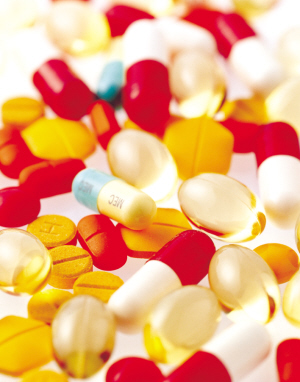
英国东英吉利大学研究人员最新发表在Diabetes Care杂志上的一篇论文称,摄取大量类黄酮化合物会显著降低Ⅱ型糖尿病女性患者心脏病发作的风险,而经常食用富含类黄酮的食物也有助于糖尿病患者的健康。
这一结论源于东英吉利大学研究人员长达一年的临床实验。93名绝经后的Ⅱ型糖尿病女性患者参加了该项实验。这些糖尿病患者年龄介于51岁到74岁之间,在为期一年的实验中,一半患者每天服用两块富含类黄酮的巧克力,这些巧克力是经过特殊加工制成,其中富含两种类黄酮化合物:黄烷3醇和异黄酮;另一半对照组患者则服用巧克力安慰剂。研究结果显示,那些摄入大量类黄酮的患者未来10年里患心脏病的风险降低了3.4%。这一效果对于饮食干预疗法来说已经是十分明显的了。同时,这些人的胰岛素抗性和胆固醇水平也明显降低。
研究人员表示,实验证明黄烷3醇和异黄酮会改善绝经期后Ⅱ型糖尿病女性患者胰岛素敏感性和脂蛋白水平,降低心血管疾病风险,而这两种类黄酮化合物是否对男性Ⅱ型糖尿病患者或其他类型病患产生同样作用,还有待进一步研究。
类黄酮又称生物类黄酮,为人类饮食中含量最丰富的一类多酚化合物,广泛存于水果、蔬菜、谷物、红葡萄酒、茶等食物或饮料之中。黑巧克力中的类黄酮含量也很高。但研究人员强调,这一研究结果并不表明Ⅱ型糖尿病女性患者就应该多吃巧克力,因为市场上的巧克力所含对身体有益的类黄酮化合物远不如实验中所用的巧克力高,过量食用会影响饮食平衡,导致体重增加等负面效果。

Chronic Ingestion of Flavan-3-ols and Isoflavones Improves Insulin Sensitivity and Lipoprotein Status and Attenuates Estimated 10-Year CVD Risk in Medicated Postmenopausal Women With Type 2 Diabetes
Peter J. Curtis, PHD, Mike Sampson, MD, John Potter, MD, Ketan Dhatariya, MD, Paul A. Kroon, PHD and Aedín Cassidy, PHD
OBJECTIVE: To assess the effect of dietary flavonoids on cardiovascular disease (CVD) risk in postmenopausal women with type 2 diabetes on established statin and hypoglycemic therapy.
RESEARCH DESIGN AND METHODS: Despite being medicated, patients with type 2 diabetes have elevated CVD risk, particularly postmenopausal women. Although dietary flavonoids have been shown to reduce CVD risk factors in healthy participants, no long-term trials have examined the additional benefits of flavonoids to CVD risk in medicated postmenopausal women with type 2 diabetes. We conducted a parallel-design, placebo-controlled trial with type 2 diabetic patients randomized to consume 27 g/day (split dose) flavonoid-enriched chocolate (containing 850 mg flavan-3-ols [90 mg epicatechin] and 100 mg isoflavones [aglycone equivalents)]/day) or matched placebo for 1 year.
RESULTS: Ninety-three patients completed the trial, and adherence was high (flavonoid 91.3%; placebo 91.6%). Compared with the placebo group, the combined flavonoid intervention resulted in a significant reduction in estimated peripheral insulin resistance (homeostasis model assessment of insulin resistance [HOMA-IR] −0.3 ± 0.2; P = 0.004) and improvement in insulin sensitivity (quantitative insulin sensitivity index [QUICKI] 0.003 ± 0.00; P = 0.04) as a result of a significant decrease in insulin levels (−0.8 ± 0.5 mU/L; P = 0.02). Significant reductions in total cholesterol:HDL-cholesterol (HDL-C) ratio (−0.2 ± 0.1; P = 0.01) and LDL-cholesterol (LDL-C) (−0.1 ± 0.1 mmol/L; P = 0.04) were also observed. Estimated 10-year total coronary heart disease risk (derived from UK Prospective Diabetes Study algorithm) was attenuated after flavonoid intervention (flavonoid +0.1 ± 0.3 vs. placebo 1.1 ± 0.3; P = 0.02). No effect on blood pressure, HbA1c, or glucose was observed.
CONCLUSIONS: One-year intervention with flavan-3-ols and isoflavones improved biomarkers of CVD risk, highlighting the additional benefit of flavonoids to standard drug therapy in managing CVD risk in postmenopausal type 2 diabetic patients.
文献链接:https://care.diabetesjournals.org/content/35/2/226.abstract?sid=cd2e89b3-7b8e-442d-ae39-551082213f76








